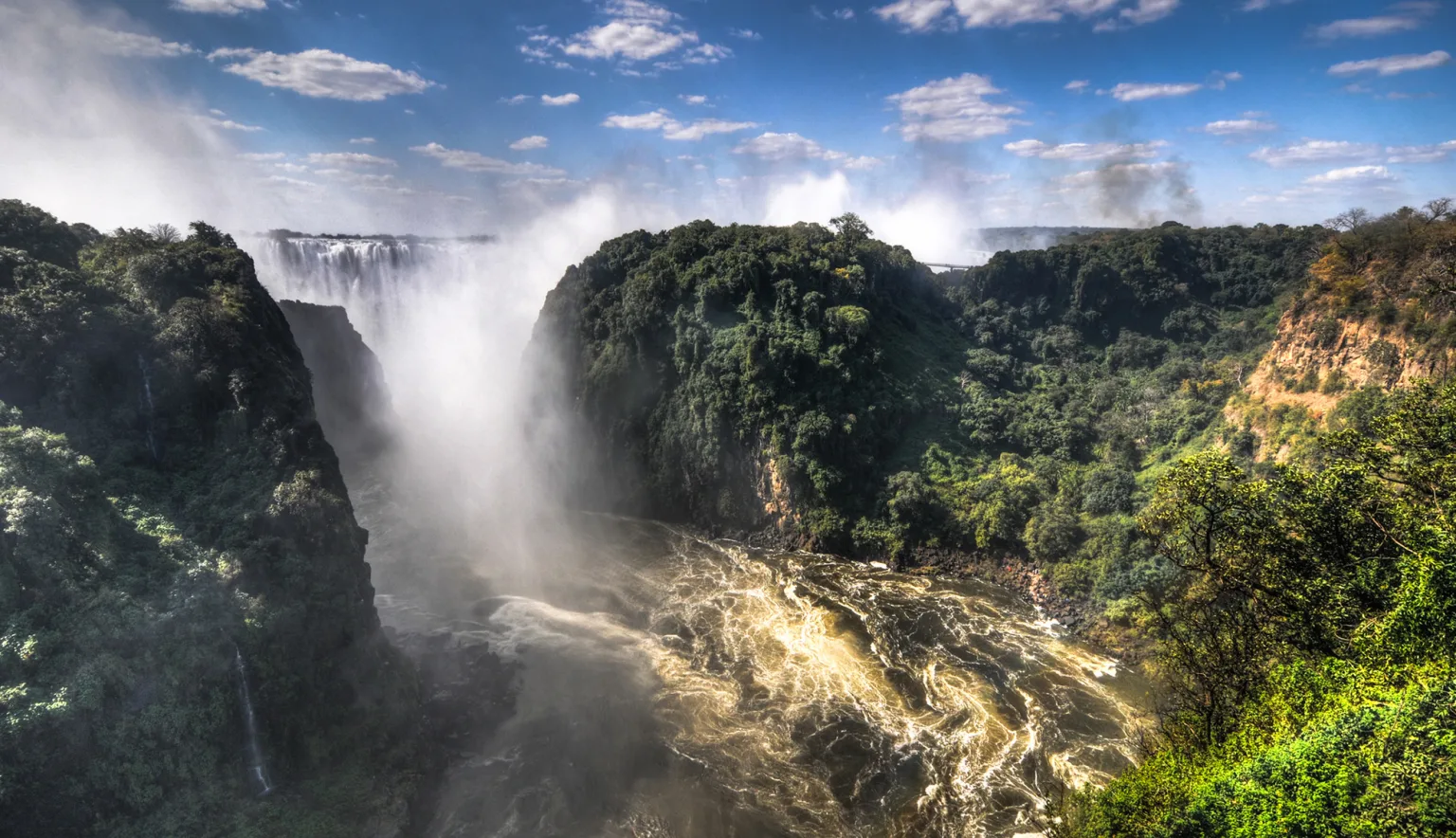Situated in close proximity to some of the world’s most stunning national parks, Livingstone is propelling Zambia’s tourism industry.
LIVINGSTONE
Once the capital of Zambia when it was better known as Northern Rhodesia, Livingstone lies along the country’s southern border with Zimbabwe, just north of world-famous Victoria Falls. A bustling European settlement in years gone by, evident in the city’s widely visible Edwardian buildings, Livingstone was named after Dr David Livingstone, the explorer who famously toured the southern reaches of the African continent in search of the source of the Nile.
Fast forward to the present day, Livingstone now largely serves as a major tourist hub, surrounded by some of the world’s most amazing national parks including Mosi-oa-Tunya, Lake Kariba, Livingstone Game Park, and the Kafue and Hwange reserves. The main event, however, is the nearby Victoria Falls. Stretching across the national border, the UNESCO World Heritage Site has often been described as the world’s largest waterfall at 1.7 kilometres wide and 360 feet tall.
A place defined by natural beauty, described by Dr David Livingstone himself as providing views that must have been “gazed upon by angels in their flight”, Livingstone and the surrounding region is a relaxed yet vibrant region, and one that has understandably become a backpacking hotspot on the continent.
THE BUSINESS END
With a present population of almost 140,000 people, Livingstone is comfortably one of Zambia’s larger cities and a key contributor to the national economy. Zambia’s national economic troubles very much mirror those of many other Africa nations, heavily depending on copper exports that have tethered the country’s success to fluctuations in the metal’s price for decades. In fact, it is estimated that as much as 80 percent of its export earnings come from copper. However, known as the tourist capital of Zambia, Livingstone itself is playing a key role in helping to diversify national revenue streams, with the city’s ecosystem and employment generation very much owed to the ever-growing tourism scene.
More than 250,000 travellers the world over visited the city during 2018, up from the 183,000 that was recorded for the previous year. Accelerated by increasing marketing and product development efforts from organisations such as the Livingstone Tourism Association, the city’s and wider country’s prospects are looking fruitful as a result of this surge in tourism. Essentially, Livingstone is actively harnessing this as a vehicle of economic development and sustainability.
OUTLOOK RECOMMENDS
STAY:
DO:
TOURS:
NATURE:
OUT AND ABOUT IN LIVINGSTONE
Alongside its status as the tourist capital of Zambia, Livingstone is also known as the adventure capital of Africa, named as such due to the substantial number of adrenaline-inducing activities on offer. Many of these, as expected, are centred around the Zambezi River and Victoria Falls – two highlight attractions of the region. Tourists can enjoy a host of activities, from river boat safaris, canoe trips and white-water rafting to micro flights, helicopter flights and even bungie jumping over the falls.
A particular highlight for many is a visit to Devils Pool. Often described as the world’s most amazing infinity pool, visitors can swim on the edge of Victoria Falls. It’s not for the faint of heart, but for those looking to capitalise on Livingstone’s offerings of adventure, this is a must-do bucket list experience. The region’s aquatic scene aside, Livingstone is home to a number of extensive on land offerings. Outside of the city centre, quad bike and horseback trails are widely available and a great way to explore some of the region’s plains, while a variety of national parks nearby provide the opportunity to see some of Africa’s most revered wildlife, from elephants to lions.
The city itself is less of an attraction, largely serving as tourism hub for the wider region. The Livingstone Museum, however, is worth a visit with it being the oldest museum in the country. Within its walls, the building showcases the story of Zambian colonialism and independence from a more nationalistic perspective, alongside a room dedicated to Dr David Livingstone and information about Zambia’s 73 recognised tribes.
GETTING THERE AND AROUND
Home of the Harry Mwanga Nkumbula International Airport, Livingstone is serviced by domestic, regional and international airlines. Flights to Livingstone tend to be cheaper than the alternative Victoria Falls Airport, so it is worth bearing this in mind if you are planning on visiting the region, particularly with Victoria Falls being situated less than 20 kilometres from both airports. Meanwhile, the city is well connected to the rest of Zambia by rail, the main line being the link between the city itself and Lusaka, the capital, with many stops in between. Meanwhile, for those who prefer to travel in comfort there is also the Luxury Rovos Rail that provides direct links to Victoria Falls, renowned for its top-notch hospitality.
For those hoping to get around by road during their visit to Livingstone, there are equally plenty of options available. The use of taxis is arguably the easiest way to navigate the city, with its world-famous blue vehicle fleets easy to spot and found in an abundance across its streets, providing cheap transport at ease. Between Livingstone and the Zimbabwean border, a taxi ride will generally cost between 60 and 80 ZMK, equating to around $5-7.
Buses and car hire are also recommended, particularly for longer journeys. The route between the capital city Lusaka and Livingstone is ideal for driving, with comfortable bus providers offering one-way trips for just $11, while the road equally lends itself to being self-navigated, with high-quality tarmac found throughout the 470-kilometre stretch.






















